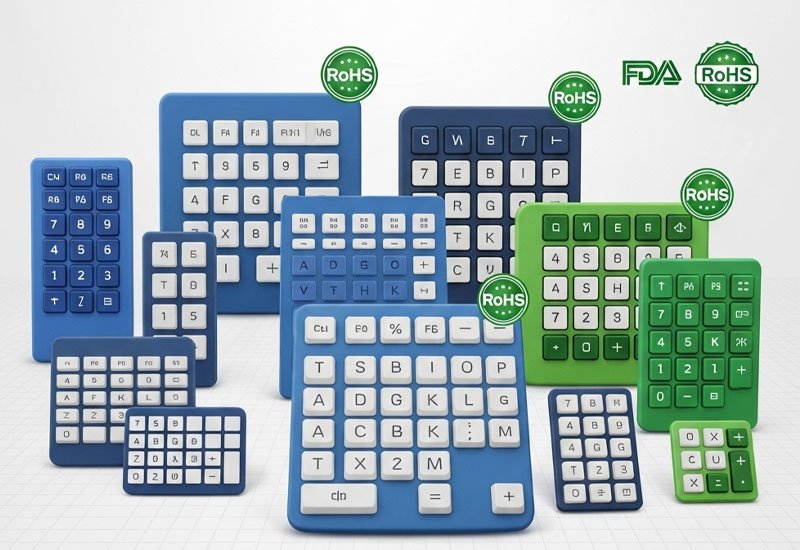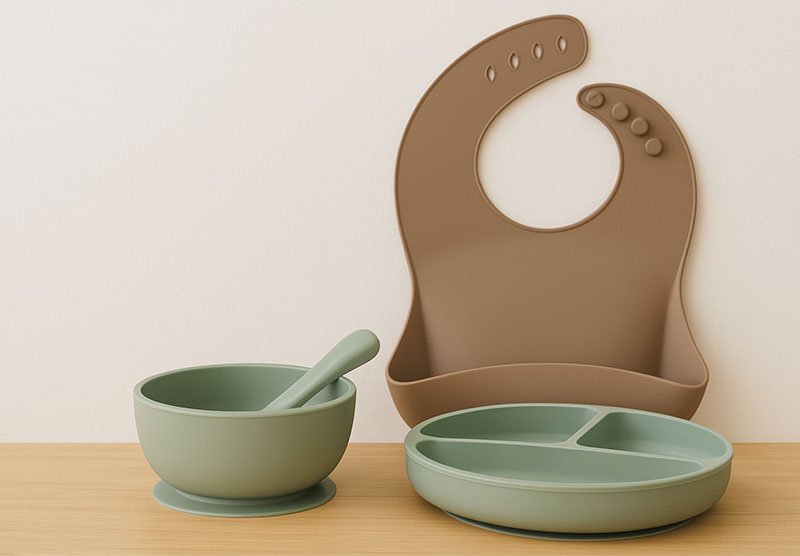If your silicone keypad fails compliance, your whole product might be illegal to sell. It’s not just a checkbox—it’s a barrier to entry.
FDA and RoHS compliance ensures that silicone keypads are safe for food and medical contact (FDA) and free from harmful substances (RoHS), allowing them to be legally sold and used worldwide.
These certifications don’t just protect users—they also protect your brand. I’ve helped clients navigate compliance on medical and consumer electronics projects. Here’s what I’ve learned and what you need to know.
What is FDA Compliance for Silicone Keypads?
Safety first—especially in food and medical tools.
FDA compliance means the silicone material used in keypads meets U.S. Food and Drug Administration standards for non-toxicity and food or skin contact safety.
FDA-compliant silicone must not leach harmful chemicals, discolor under contact, or degrade under heat. It’s commonly used in kitchen appliances, baby products, and medical devices.
Key requirements include:
- Use of FDA-approved base silicone
- No banned additives or colorants
- Resistance to temperatures -40°C to 200°C
- Must pass extractables and leachables tests
I once worked on a silicone keypad for a medical sterilization unit. We had to source platinum-cured silicone to ensure it met Class VI biocompatibility standards. No shortcuts.

What is RoHS Compliance and Why Does It Matter?
Toxic substances aren’t just bad for health—they’re illegal in many markets.
RoHS (Restriction of Hazardous Substances) compliance ensures that silicone keypads are free from harmful chemicals like lead, mercury, and phthalates, aligning with EU and global safety laws.
RoHS originated in the EU but is now widely adopted. It restricts the use of:
- Lead (Pb)
- Mercury (Hg)
- Cadmium (Cd)
- Hexavalent Chromium (Cr6+)
- Polybrominated Biphenyls (PBB)
- Polybrominated Diphenyl Ethers (PBDE)
Silicone itself is usually RoHS-safe, but colorants, coatings, and conductive pills can introduce banned substances. That’s why testing must be done on the final keypad, not just the base material.
I always request third-party lab certification for RoHS. It’s not worth the risk—non-compliant parts can be banned from sale, recalled, or fined.
How Do You Test for FDA & RoHS Compliance?
You need more than a promise—you need proof.
Compliance is verified through third-party testing labs that perform chemical analysis, migration testing, and documentation audits on silicone keypads.

For FDA, labs typically test:
- Migration of chemicals in food simulants
- Heat resistance and color stability
- Material composition verification
For RoHS, labs use:
- X-ray fluorescence (XRF)
- Gas chromatography/mass spectrometry (GC/MS)
- Wet chemical analysis
Certification documents should include:
- Certificate of Conformance (CoC)
- Material Safety Data Sheet (MSDS)
- Test Reports from certified labs
Never rely on self-declared compliance. If your supplier doesn’t provide documentation, it’s a red flag.
Why Compliance Matters for Medical and Baby Products?
Some markets have zero tolerance for non-compliance.
In medical and baby products, FDA and RoHS compliance are non-negotiable. They guarantee safety for vulnerable users and legal access to strict markets.

When designing baby bottle parts or hospital equipment interfaces, the risk of contamination or toxin exposure must be eliminated. FDA-grade materials ensure no dangerous substances can transfer during use.
RoHS adds another layer—keeping electronics and colored parts safe from heavy metals and endocrine disruptors.
I once consulted for a baby monitor brand. Their overseas supplier used unverified pigments. It delayed the launch by three months because they had to redo testing. Lesson: verify early.
How to Source Compliant Silicone Keypads?
Don’t assume—ask the right questions.
To source FDA and RoHS compliant silicone keypads, choose suppliers who provide full material traceability, third-party certifications, and transparent documentation.

Here’s what I look for in a supplier:
- FDA and RoHS certification on file
- Transparent bill of materials (BOM)
- Clear records of material batch numbers
- Coating and pigment compliance tests
Ask these questions:
- What type of silicone is used (platinum or peroxide-cured)?
- Are colorants FDA or RoHS approved?
- Can I see lab reports for each batch?
A reliable supplier will answer without hesitation. If not, move on.
What Are the Risks of Non-Compliance?
One mistake can shut down an entire product line.
Non-compliance with FDA or RoHS can lead to product recalls, import bans, legal penalties, and damage to your brand’s reputation.
Regulatory bodies like the FDA or EU customs can audit your product. If you can’t produce documentation or fail lab testing, your product can be:
- Denied market entry
- Subject to public recall
- Fined or penalized
Worse, it could harm users. And once trust is lost, it’s hard to rebuild. I’ve seen startups collapse because they skipped compliance.
Conclusion
FDA and RoHS compliance for silicone keypads ensures safety, legality, and peace of mind. It’s not optional—it’s your foundation for success.